Guide to Referral Program Rewards
It’s easy to understand how offering a reward in exchange for a referral motivates your customers, boosts engagement, and increases your chances of conversions.
But one of the most common questions we get is “what should we offer as a referral reward?”
Finding the “best” reward for your referral program is a combination of understanding industry trends, knowing what’s relevant, what your company can offer, and what motivates your customers. In other words, knowledge is power.
To help, we surveyed 102 of today’s top referral programs across industries to understand what the referral reward landscape actually looks like.
Using this data, we’re able to uncover trends and help you make informed decisions when it comes to building or updating your own customer referral program.
Why should you carefully consider your referral program’s rewards?
Rewards play a huge part in the profitability of your referral program. They affect how many times a referral is shared, and how often it converts. But if your reward is too small, customers won’t participate, and if it’s too costly, you’ll end up bankrupt.
So whether you’re already running a referral program or are brand new to the referral space, understanding the trends in today’s referral programs gives you the insight needed to make the best decisions for your own brand’s rewards.
Referral Program Reward Distribution: All Industries
What are today’s companies offering as referral program rewards?
Terminology:
- Promoter: A business's existing customer, who participates in a referral program to invite their friend, colleague, or family member to the product or service being promoted.
- Referred Friend: A person who has been invited to a product or service by way of their friend’s referral.
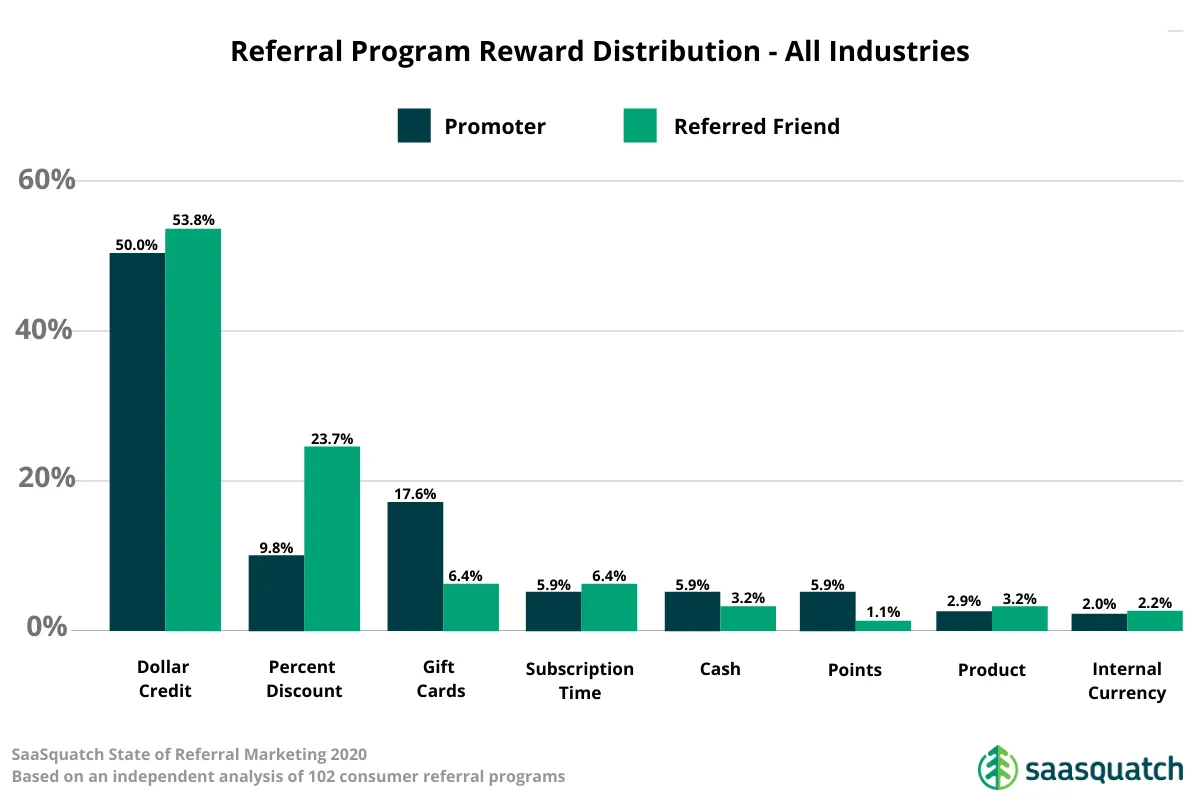
Click to share this data with your LinkedIn network!
Dollar Credit is the most common referral program reward type, used in over 50% of programs for both the promoter and referred friend.
The chart above shows the popularity of each reward type across all industries and business models. Because many programs offer different rewards to the promoter (a.k.a. the customer who makes the referral) and the referred friend, totals are separated for Promoter rewards and Referred Friend rewards.
Dollars of credit is offered more than twice as much as the second most popular reward type, Percent Discount, indicating that the simplest, most easy-to-communicate reward types remain at the forefront of the reward spectrum.
Keep in mind that our reward distribution analysis includes all types of industries*, and both transaction and subscription-based business models. Therefore, an analysis exclusively on subscription brands only would yield a higher usage of Subscription Time as a reward, and so on.
*Industries include, but are not limited to, telecommunications, fashion, technology, SaaS, financial services, consumer goods, electronics, travel & tourism, education, and healthcare.
What does the data tell us about referral program rewards?
At a high-level, this data tells us that in today’s referral landscape, simplicity reigns supreme. The majority of companies are sticking with rewards that customers know and understand, while few have embraced unique currencies and gifts that may take more effort to communicate.
What does the data tell us about each reward type?
Dollar Credit
Used by brands like: Uber, Airbnb, Rothy’s, TaskRabbit, Skip the Dishes, Flytographer
Dollars of credit is very easy to communicate to both new and existing customers, so it makes sense that it’s the most popular choice (used in over 50% of programs). It’s simple for customers to use and provides an obvious benefit when shopping. It also gives the recipient a reason to make another or a first purchase.
For double-sided referral programs (where both the promoter and referred friend receive a reward) dollars of credit are a good reward choice for quickly communicating a level playing field for both parties.
Top brands like Uber, Airbnb, Flytographer, and Indochino all user dollars of credit to drive referrals from existing customers. This reward can easily be applied to many different business models, though it works best when customers are likely to make relatively frequent purchases.
However, dollars of credit can be difficult to implement when it directly interfaces with billing systems, temporarily reduces revenues and has real costs if you sell a physical service or product.
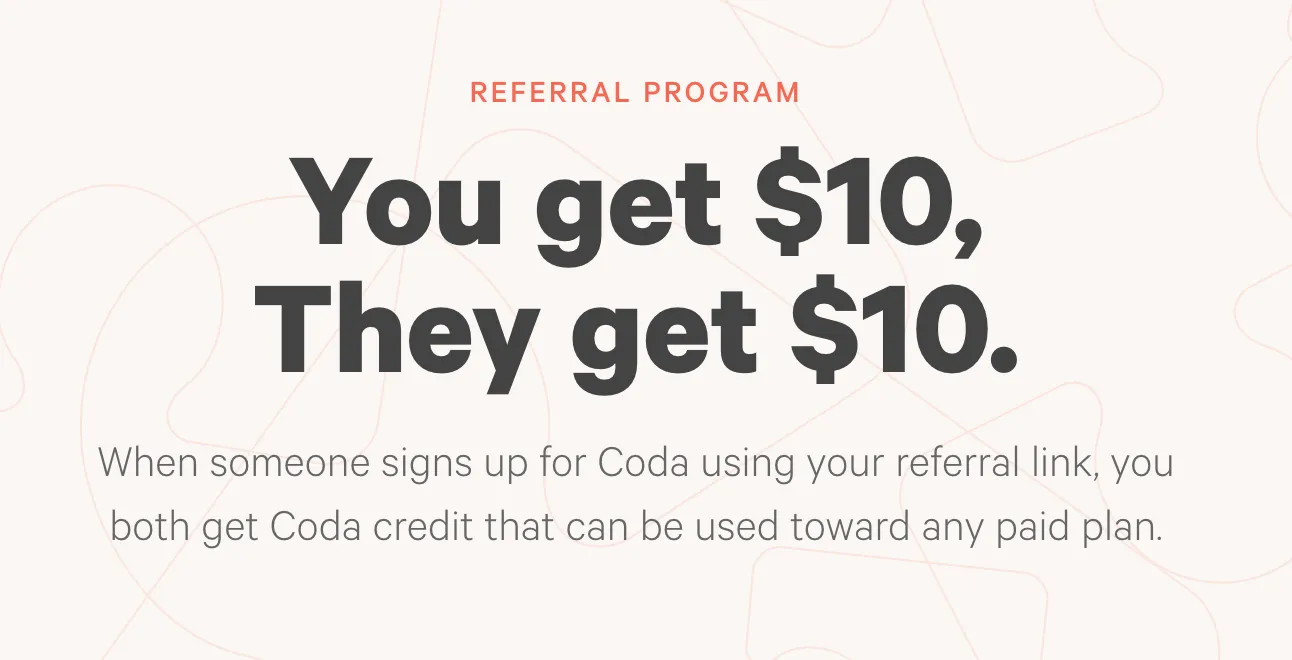
Dollar Credit Example: Coda (cloud-based document editor)
Percent Discount
Used by brands like: Society6, SmugMug, Typeform, MeUndies, Fiverr
Another popular reward choice (offered to referred friends in 23.7% of programs), percent discounts provide direct value to new and existing customers. It’s common for referred friends to receive this reward in an attempt to encourage their first purchase and reduce the initial cash outlay.
One reason to offer a percentage discount over a dollar credit is if you want to offer a discount on a wide range of products. This ensures that the discount is consistent based on the price of the item and you can still maintain positive margins on each sale.
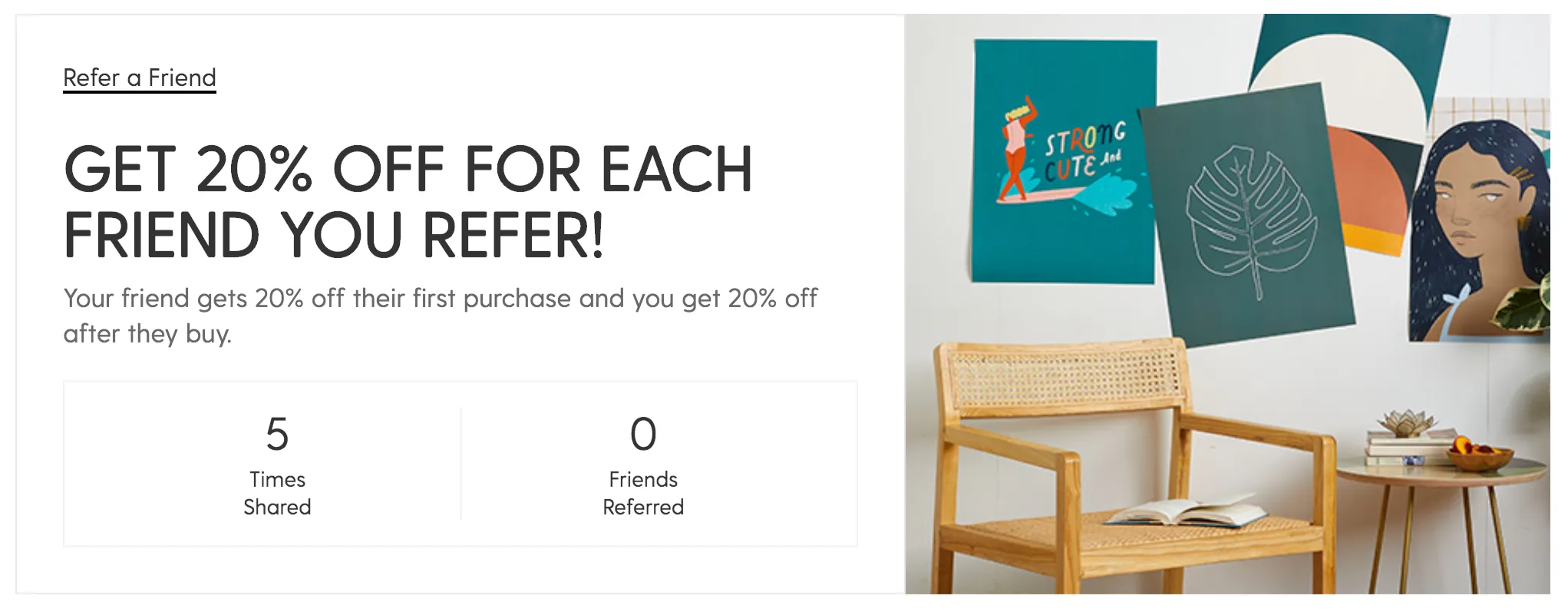
Percent Discount Example: Society6 (online home goods retailer)
According to marketing professor Jonah Berger in his book “Contagious: Why Things Catch On”, choosing between framing your discount as a percent (ie. 15% off) or an absolute dollar value (ie. $50 off), depends on the price of your item, which affects how customers perceive the discount’s value.
He outlines The Rule of 100, which says that for items priced under $100, percentage discounts appear larger to customers than absolute ones. But over $100, things reverse and absolute discounts seem larger than percentage ones.
For example, for a $20 item, a “25% discount” and “$5 discount” produce the same outcome, but a discount of 25% may be perceived as a better value simply because 25 is greater than 5.
Gift Cards
Used by brands like: T-Mobile, Sprint, Endy, Casper, Habito, 23andMe
Common in industries with irregular purchases (ie. mattresses, phone plans), third-party gift cards are a reward that your customers can redeem right away after referring new friends even if they don’t need to buy from you in the near future.
Gift cards are also a great option when you’re trying to implement rewards quickly without touching billing systems.
Plus, gift cards have the advantage of not being subject to unauthorized sharing or broadcasting across user networks, and are more secure to send than straight cash.
In our analysis, we found that gift cards are often used to reward Promoters (a.k.a. The referring friend) for referrals in industries with low-purchase frequencies. Some examples include:
- Telecom providers (ie. Sprint, Verizon, T-Mobile)
- Online mattress retailers (ie. Endy, Casper, Amerisleep)
- Online medical appointment booking services (ie. OpenCare)
- Travel booking websites (ie. Dream Vacations)
- Online insurance and mortgage brokers (ie. Trussle)
In our article on “When, Why and How to Use Gift Cards as Referral Rewards”, we explain in more detail how this makes sense because items like mortgages, mattresses, and vacations aren’t purchases that most people make often.
This means that offering a discount coupon to the promoter for referring a friend won’t excite them, as they’ll need to wait months or years before they’re due for another purchase and can finally redeem it.
Overall, third-party gift cards are understandably a lesser-used reward for the referred friend (offered only 6.4% of the time) as they don’t promote continued engagement with your product. You would ideally offer something that encourages this new user to try out your product or service, like a discount or credit.

Gift Card Example: Endy (online mattress retailer)
Subscription Time
Used by brands like: Skillshare, Duolingo, Netflix, Todoist, Jobber
Only applicable to subscription businesses, this reward has a low presence among all industries (offered to promoters in 5.9% of programs, and to referred friends in 6.4% of programs). In theory, many subscription time rewards are simply equal to dollars of credit (ie. when one month’s subscription costs $10, giving a $10 credit has the same value).
As the name suggests, subscription time rewards are mainly used as referral rewards by streaming services, SaaS platforms, and content subscriptions like e-learning platforms.
However, subscription time rewards can also be a great way to encourage upsells by giving customers limited-time access to a premium subscription. Exposing users to paid features lets them understand the value and increases the likelihood that they’ll pay for it themselves.
This is how Duolingo, the language learning app, offers their subscription time rewards. The app is free to use, but when you refer a friend who signs up, you then receive a week of Duolingo Plus, which is the app’s paid tier. It offers premium features like an ad-free experience, the ability to download lessons in the app for offline use, and more options to enhance the gamification experience.
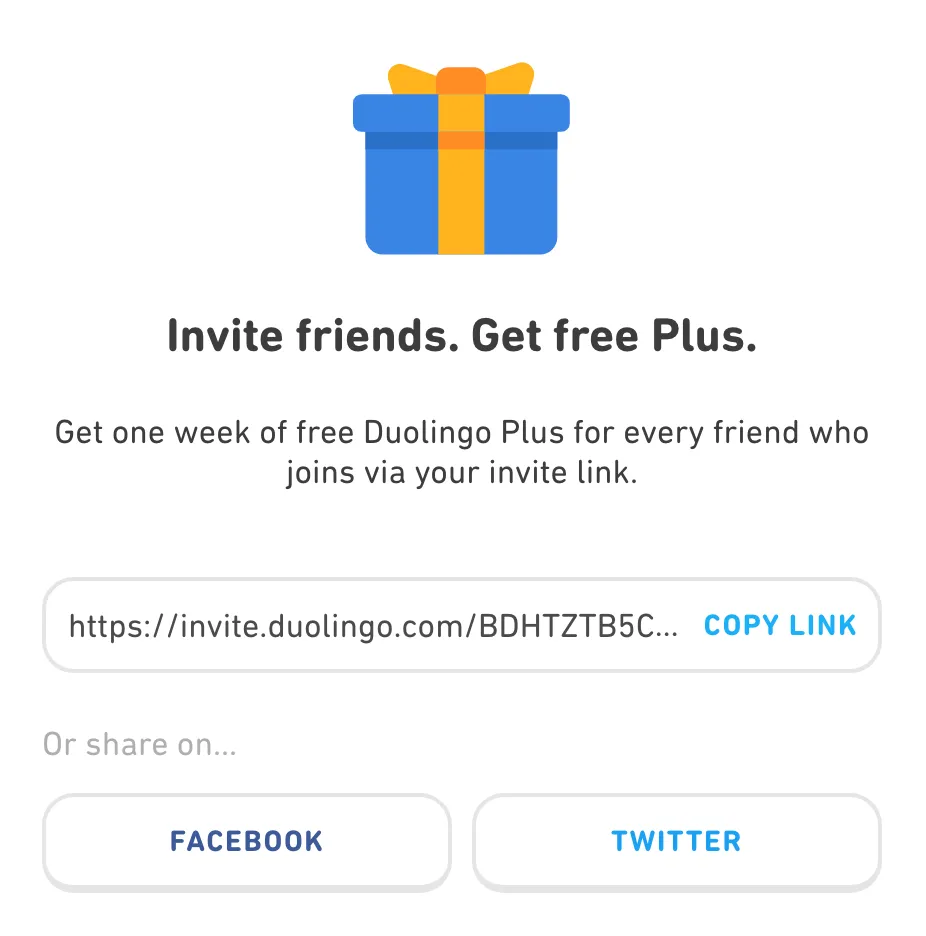
Subscription Time Example: Duolingo (language learning app)
Cash
Used by brands like: Tangerine, Payoneer, Rakuten, Leesa
Use of cash as a reward is low, which is expected for referral programs (used to reward promoters in 5.9% of programs, and to reward referred friends in 3.2% of programs). Cash can be hard to give out because you’ll likely need to collect and store personal user information like mailing address and/or bank information in order to deposit cash.
Not only can cash rewards cost you up to three times more and be difficult to manage when dealing with multiple currencies, they also don’t guarantee more engagement with your product or service.
However, cash works well in industries like financial services where a cash deposit into a user’s account is deemed an acceptable reward and logically fits with the product. Top financial brands like Payoneer and Tangerine use cash to encourage referrals from existing customers.
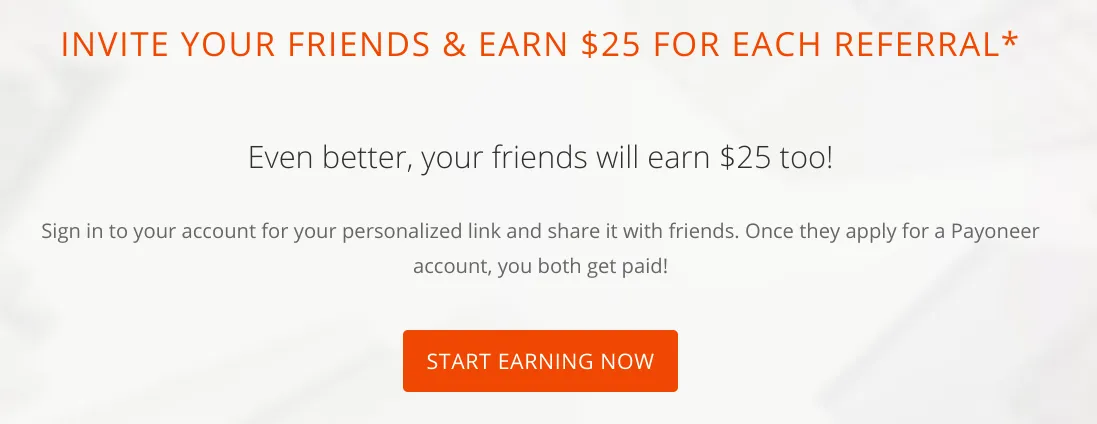
Cash Example: Payoneer (financial services company)
Points
Used by brands like: Evernote, Samsung, Care/of, Canva
It can be difficult to quickly communicate the value of points in referral programs -- especially to brand new customers -- which explains why they are mostly awarded to existing customers (used to reward promoters in 5.9% of programs, and to referred friends in only 1.1% of programs).
It’s also common for points to be advertised as dollars of credit (ie. “Get $10 worth of points for every referral”) to give customers a clear value. This framing decision contributes to the high usage of dollar credit as a reward.
Points can be a good way to offer a diverse set of incentives when they can be exchanged for a catalogue of rewards. This lets users set unique point-collection goals for themselves depending on what reward they find most desirable. For example, they may be the type to exchange points on a regular basis for smaller rewards, or fixate on the ultimate reward which requires substantial point collection.
The most common issue with points is lack of immediacy, since customers aren’t necessarily receiving a tangible reward after every purchase. This makes it important to ensure that customers are able to redeem at frequent intervals.
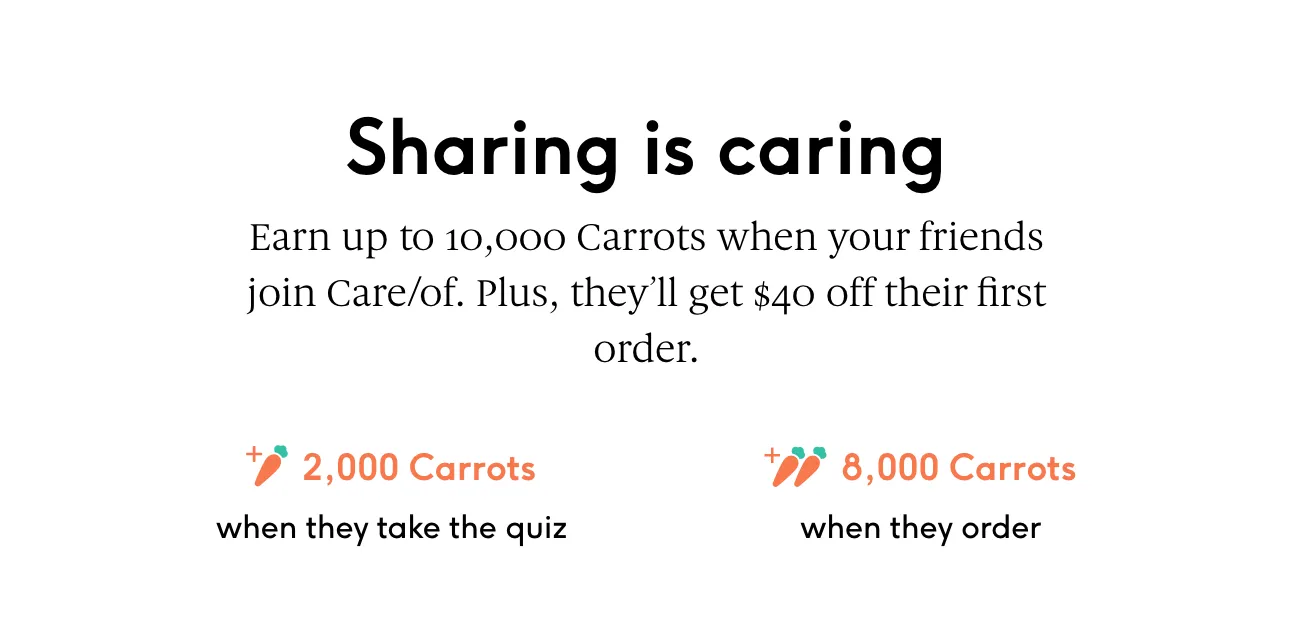
Points Example: Care/of (vitamin subscription service)
Product
Used by brands like: Native, Threadbeast, Shutterfly
Use of physical merchandise as a reward is low (offered to promoters in 2.9% of programs, and to referred friends in 3.2% of programs), most likely due to the logistical challenges and shipping costs involved.
Product is generally only awarded when a physical package is already being shipped anyway, making it a suitable choice for e-commerce brands. For example, the referred friend might receive a bonus gift in their first order, and the promoter will be able to add a special gift when they place their next shipment.
Product rewards can also take the form of branded gifts or company swag. Company shirts, socks, stickers, mugs, or other items can all be repurposed as referral rewards. Wearing your company’s “uniform” helps customers feel like they are part of your brand’s movement, and doubles as an extra form of advertising.
Company swag rewards were seemingly underused based on our data, though we anticipate they would be more common in a B2B referral program where it would be acceptable to send branded items for use in the advocate’s office.
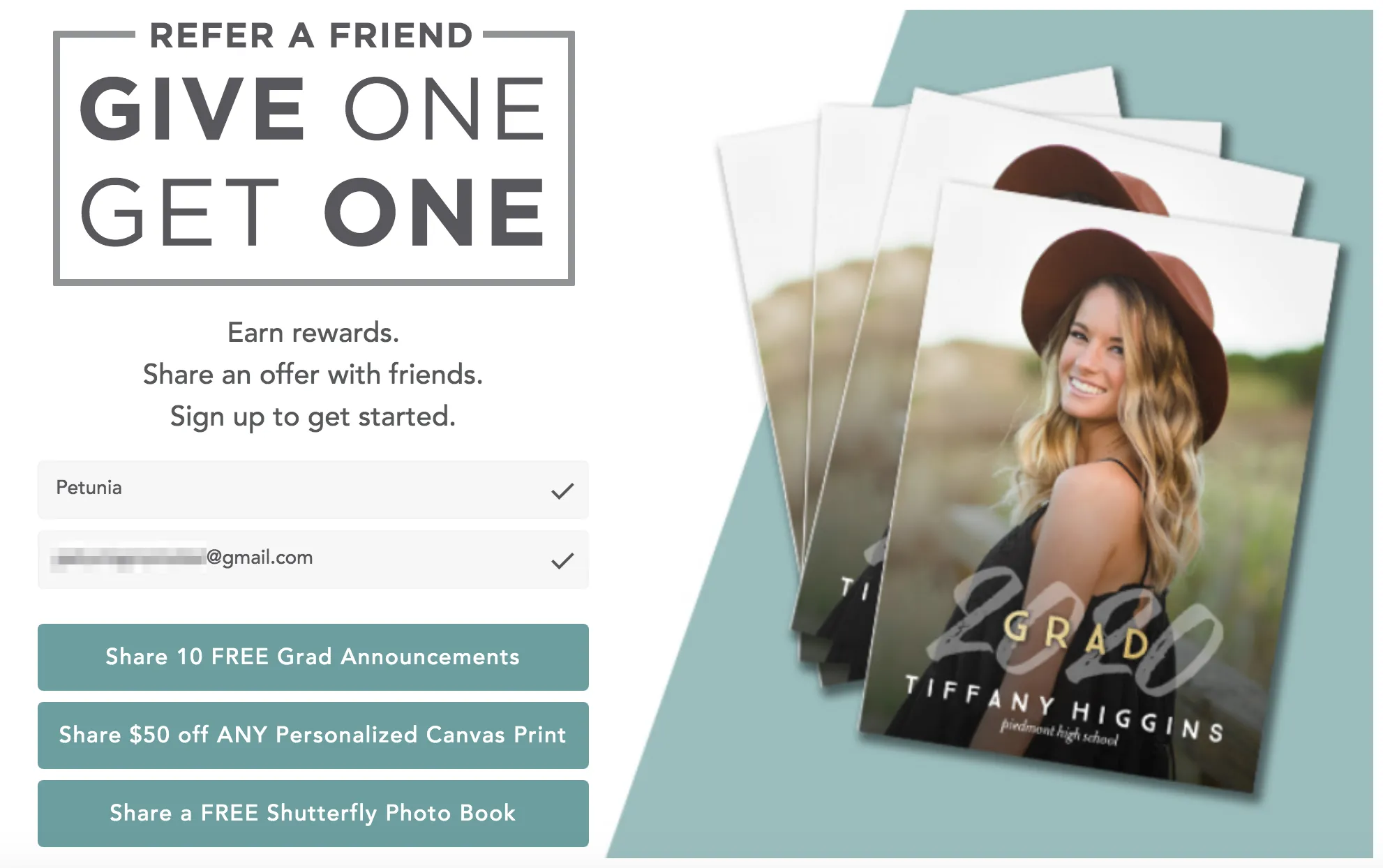
Product Example: Shutterfly (photography products)
Internal Currency
Used by brands like: Dropbox, Sync
Pioneered as a referral reward by Dropbox who offers megabytes of storage, internal currencies are gaining traction, but their complexity leaves them underused (offered to promoters in 2.0% of programs, and to referred friends in 2.2% of programs). It should be noted that this kind of reward simply isn’t an option for all business types as is a universal reward like dollar credit or percent discounts.
Rewarding participants with your own “business currency”, is one of the most cost-effective ways to drive product usage and establish a competitive advantage.

Internal Currency Example: Dropbox (cloud storage app)
Is this all you can offer for your referral program?
Know of a reward that isn’t mentioned here? While the eight rewards listed above are by far the most well-known, unique incentives under the alternative currency umbrella are peaking the interest of program designers.
We suspect these haven’t made a noticeable mark in the referral landscape due to their complexity, but you can read more about those here.
So, what is the best reward for your referral program?
As much as we would love to say it, there is no magic formula for choosing the perfect reward every single time. But that’s why we’re here to help.
Finding the best reward is a combination of understanding industry trends, what’s relevant, what your company can offer, and what motivates your customers.
We know that there is no one-size-fits-all reward, which is why we work with you to help answer each of these questions and develop a plan that fits your brand. We use industry data like what you’ve just read, case studies and details about your business and customers.
Plus, working with a dedicated customer referral platform like SaaSquatch means that once your program is launched, it’s easy to monitor your program’s results and change your rewards as needed.
Even the best companies like Airbnb and Tesla test and iterate rewards to find what works for them. From swapping reward types and values to completely re-launching the program, their referral programs have gone through multiple iterations to try and land the best results.
This is why our success team is always with you to offer expertise when it comes to deciding your next steps.